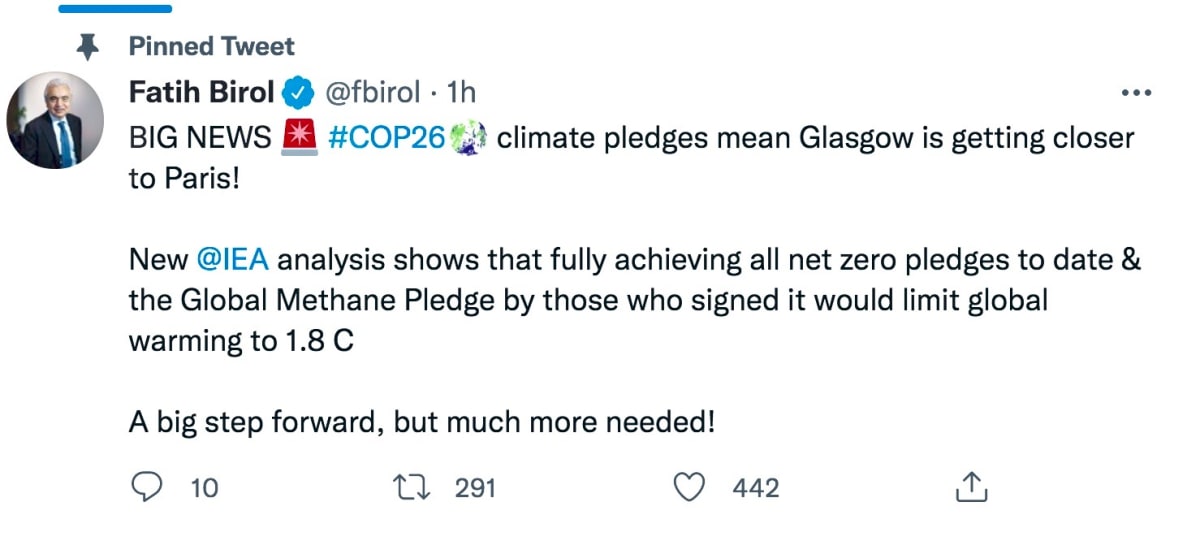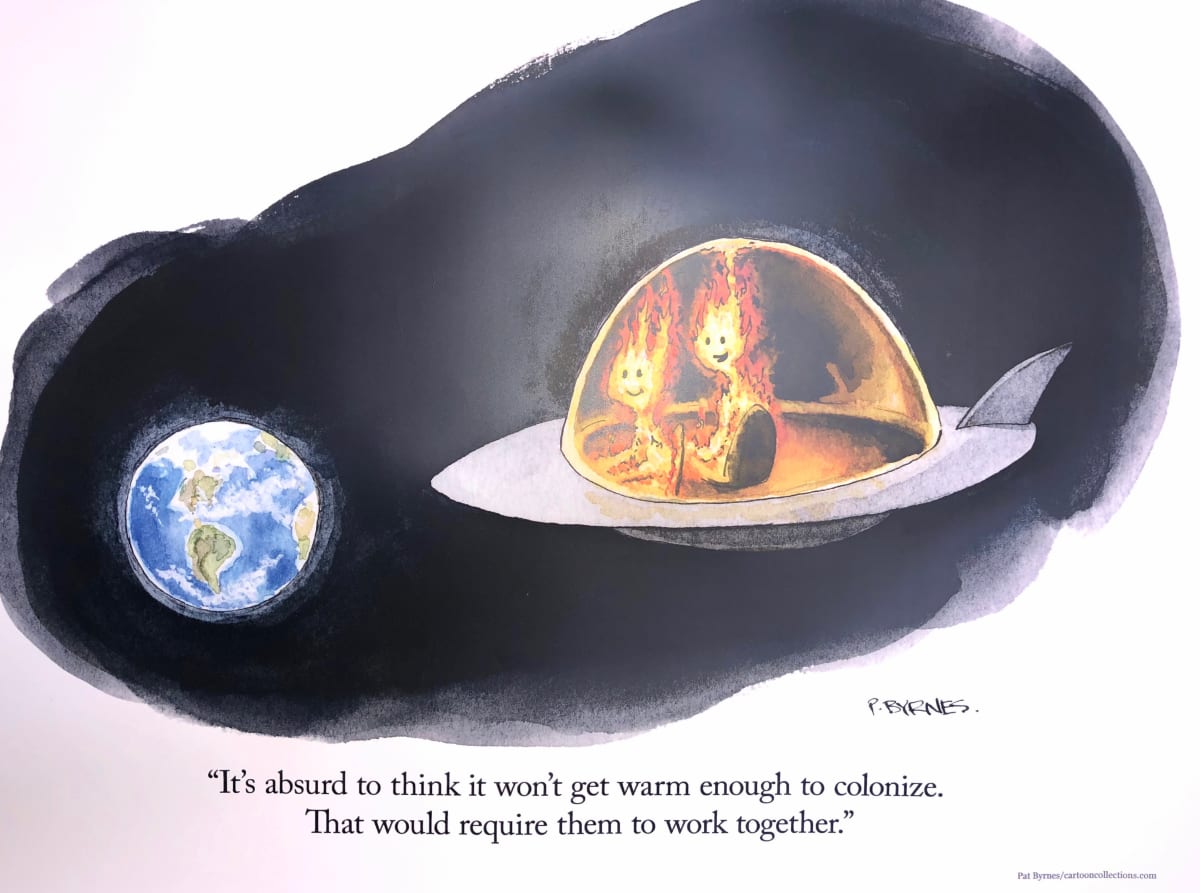Suddenly, the gloom at COP26 lifts
COP26
After a slow beginning, the UN climate summit sees real progress made towards the 1.5 percent goal for global emissions. Rod Oram reports from Glasgow
At 10am Thursday, designated Energy Day at the COP26 climate negotiations, an unexpected but welcome Tweet went viral:
Just four days earlier the global meeting in Glasgow had started on a gloomy note. The UN said 2.5C would be the likely temperature rise, based on the pledges so far from the countries of the world. Far adrift of the 1.5C goal for COP26, set because higher temperatures will rapidly escalate the climate crisis.
First India had stepped up, followed by some other countries. But 1.5C still seemed very elusive, even more so after heads of most major countries left Glasgow after their two-day summit.
But then came this sudden breakthrough, which was likely achieved with the help of a large group of smaller countries plus the Global Methane Pledge. Announced on Wednesday, it is the commitment by more than 100 countries to achieve a 30 percent cut in the highly potent greenhouse gas by 2030. Admittedly, it is non-binding; which made it easy for New Zealand to join since our goal is only a 10 percent cut.
The 1.8C news means COP26 could still deliver its core goal of 1.5C. It came from an impeccable source. Dr Fatih Birol is executive director of the International Energy Agency, an arm of the OECD, which earlier this year delivered ground-breaking research on pathways for the entire global energy system to net zero by 2050 using existing and near-term technologies.
Shortly after tweeting, Birol expounded on the theme of net zero at a session hosted by Nordic countries. They are all leaders in decarbonisation, even though Norway remains heavily reliant on Equinor, its state-owned oil and gas company formerly called Statoil.
Then, since COP26 is a global village, Birol took a short walk from countries purging themselves of fossil fuels to a country promoting them – Australia. Given his passion for clean energy, a chat with a prodigious source of greenhouse gases was likely a high priority.
With a few aides in tow, he ascended a steep stairway tucked away at the side of the expansive Australian pavilion to the upper room. Who he met and what they talked about might never be known. Unless, against all odds, one conversation, even from someone as persuasive as Birol, causes the Australians to quit their calamitous course.

When it comes to New Zealand’s transformation to a climate-compatible economy, we can see broadly how we can get to net zero on energy. Which makes agriculture our greatest liability and our overwhelming priority. Animal methane accounts for more than a third of our greenhouse gases.
Yet the Government and sector are only chipping away slowly at existing farming technology and practices. They are refusing to set the audacious goals and tight timeframes the climate crisis is demanding of all of us. Instead, they’re skimping on science and money, creativity and enterprise.
If dairy farmers were the global leaders they claim to be, a COP26 event on Thursday would have been perfect stage for them. The Global Dairy Platform was show-casing its Pathways to Dairy Net Zero which it launched in July, as I reported in this column.
An array of speakers, led by Donald Moore, GDP’s executive director and a former senior Fonterra executive, described the goals of the project. It’s highly ambitious, aiming to help all dairy farmers in the world regardless of their scale or level of skill. Three is the average herd size of the dairy farms in the world, versus more than 400 in New Zealand.
That is laudable, given the economic, environmental, nutrition and social benefits from those farmers becoming more efficient, lower emission and more sustainable. Developing country dairy farmers account for 80 percent of the global dairy industry’s greenhouse gas emissions, Moore said.
While the major dairy companies presenting in the session set their strategies in the same broad sustainability context, they failed to mention explicit hard targets and tight timeframes for making their operations, the current peak of dairying perfection, lower emissions or more sustainable.
In this, dairying is an aberration among major industrial sectors. All but a few, such as the oil and gas sector, have finally got serious about the likes of clean transport, zero carbon steel, low carbon concrete and the like. Moore said the dairy timeframe was much slower because the sector’s dealing with animals and nature which are complex so change takes time.
Yes, but nature, in the form of climate breakdown and ecosystem collapse, is the force that is setting us the excruciating deadline we confront for making major emissions reductions by 2030. So the dairy multinationals have to figure out how to respond to nature far faster, rather than hiding behind the small farmers of the world.
If the big players rapidly developed climate compatible farming systems, they would help fast forward the knowledge and practices the vast number of tiny herds elsewhere in the world desperately need.
A key component of GDP’s presentation was a montage of brief comments from a range of dairy industry people around the world, from a lot of multinationals down to small farmer representatives. Not a single word was said about dairy farming in New Zealand. Even the world’s largest dairy exporter, Fonterra, was a no show – because it had sent a video clip of poor audio quality, Moore said.
After the presentation, I interviewed Moore and Brian Lindsay, head of the Dairy Sustainability Framework, and sustainability lead at GDP. At the end of that, we recorded a brief recap which you can listen to here:
Friday at COP26 is Youth and Public Empowerment Day
“Elevating the voice of young people and demonstrating the critical role of public empowerment and education in climate action,” the COP26 Presidency Programme says.
Lastly for today, here’s another take on climate from the long cartoon wall in the main concourse of the COP26 campus:



